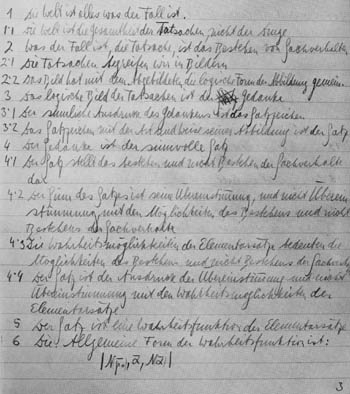Wittgenstein's Tractatus - Reviews - Your Texts - Your Stuff!
About 600 words - Originally, an Oral Presentation
Wittgenstein's Tractatus by Jonathan Marqués Moreno (Avanzado 2, 2008-2009)
 The Tractatus Logico-Philosophicus was written during the First World War – where Wittgenstein took part on the side of the Allies. I am going to try to explain the main point in this book.
The Tractatus Logico-Philosophicus was written during the First World War – where Wittgenstein took part on the side of the Allies. I am going to try to explain the main point in this book.
This essay was written to establish the limits between what we say which has a meaning and what we can say but should not, because, even though it is not nonsense, it has no meaning. The main point in the book is, then, to set the limits of language by studying both the structure of the world and the structure of thought. He does not intend to establish any language theory. He simply wishes to place Kant's question of the limits of knowledge in the framework of the limits of language. Other points he brings up are ethics, aesthetics and the question of truth.
The book starts by explaining how language expresses the world around us, and to do so he explains first the structure of the world – his cosmovision. Wittgenstein defines the world as all the facts that can happen, and did happen, by being, and all the facts that also had that possibility to happen but did not happen, by not being. Those facts that are real, that took place, plus the ones that did not occur are determined by Logic , the one rule that establishes how they all interact, which ones are and which ones are not. That Logic can be seen in the relations among objects.
Wittgenstein's Proto-Tractatus
An object is defined by Wittgenstein as anything that can be the subject of a sentence and can take part in a state of affairs, which together with other state of affairs creates a fact. Other objects, however, can stand for other objects. Let us call those "pictures of other objects." In order to represent something, both the object and its picture must share something in common: the form of representation, that is, in the real objects, Logic . As Logic is shown by looking at the relations between objects in real life, pictures show their form of picture, they do not stand for it (and neither represent it). The same inner structure that an object has in reality is what the picture must stand for.
Both language and thought are pictures of reality (a sentence stands for a fact; a noun, for an object, basically), so they show that same Logic in their sentences. Thought is always true. So that a sentence in language can be true, that sentence, thought and reality must have the same inner properties. By studying truth, Wittgenstein finds out there are different kinds of sentences: those that do not make any sense (nonsensical statements); those which are always true (statements about Logic); those that are always false (contradictions), those that can sometimes be true and sometimes false (statements about the world) and those that can neither be true or false (statements about ethics, aesthetics or religion: mystic).
Only the sentences speaking about the world should be used, as we do not need to speak about Logic because it is already shown in every sentence we make, and we cannot speak about mystic sentences, because Mystic lies beyond Logic, its objects do not stand for anything that we can see: Logic is, therefore, the limit of our language.
After reaching this point, Wittgenstein admits his book does not have any meaning (though it is not nonsensical), and that he only hopes we have realised precisely that – that we have used it to reach a higher reality, where there are no mystic sentences. He summed up the content of the book on one final sentence: "What we cannot speak about we must pass over in silence.